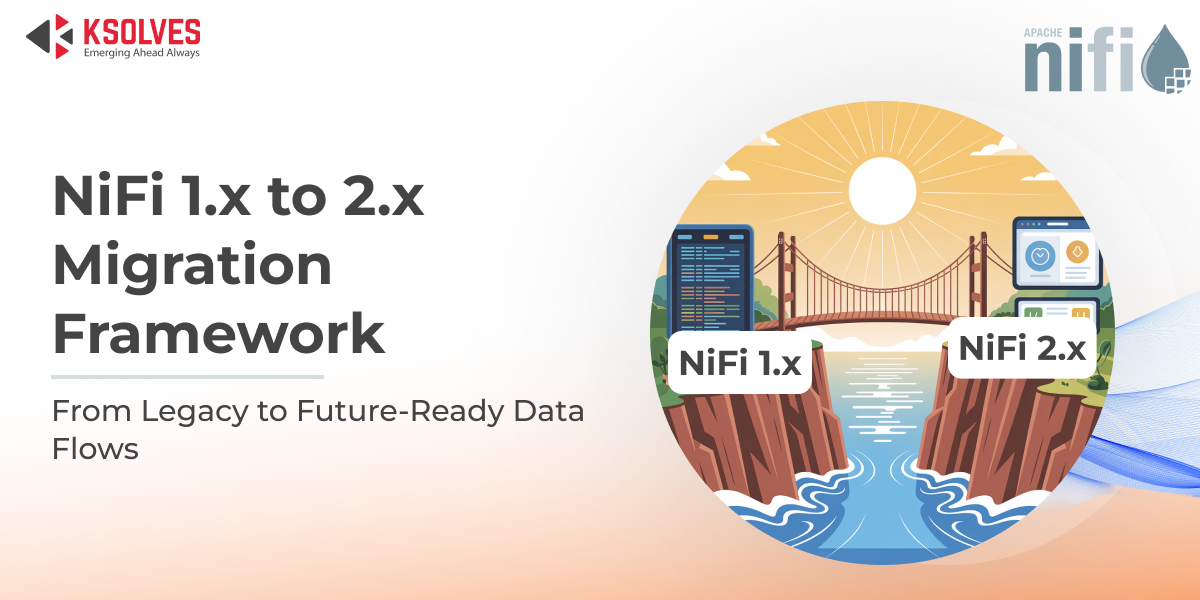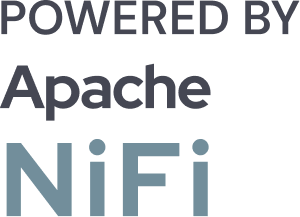How to Migrate from NiFi 1.x to 2.x: A Complete Migration Guide
![]()

Apache NiFi has long been a cornerstone for data ingestion, routing, and transformation in modern data pipelines. But with the release of NiFi 2.x, a new era has begun. This version is not just a minor upgrade; it’s a complete architectural overhaul that empowers teams to build faster, scale effortlessly, and secure their data infrastructure like never before.
If you’re still running on NiFi 1.x and wondering how to make the leap without downtime, broken flows, or chaos, you’re in the right place.
In this blog, we break down the step-by-step migration path, highlight key benefits, and share insights from real-world enterprise migrations.
Why NiFi 2.0 is Worth the Upgrade
Before diving into the detailed roadmap, let’s talk about why Apache NiFi upgrade to 2.x is crucial. Apache NiFi 2.0 introduces transformational improvements that redefine how modern data workflows are built and deployed.
1. Java 21 Foundation
NiFi 2.0 is built on Java 21, which offers substantial performance and security benefits. In client deployments, we’ve observed:
- Up to 15–20% better throughput.
- Improved memory management.
- Enhanced security capabilities out of the box.
2. Native Python Processor Support
Developers no longer need to write Java code for simple processors. With Python support:
- You can build processors quickly.
- Eliminate lengthy Java build cycles.
- Focus on business logic, not boilerplate.
3. Kubernetes-Native Design
Designed for the cloud from the ground up:
- Seamless auto-scaling.
- Better resource allocation.
- Tight integration with Kubernetes and container orchestration.
4. Enhanced Enterprise Security
NiFi 2.0 addresses enterprise compliance concerns with:
- OIDC integration.
- Stronger certificate management.
- Granular access controls for role-based security.
These changes are monumental, but they also make migration more complex. Let’s explore how to tackle that complexity with clarity.
Our Performance Benchmarks for NiFi 2.0
At Ksolves, we’ve already helped clients make the switch, and the performance numbers speak for themselves:
- 25% faster data processing, resulting in smoother throughput
- 30% less memory consumption, which translates to lower infrastructure costs
- 40% quicker startup times, improving system responsiveness and agility
These aren’t any theoretical benefits, but production-tested results.
A Complete 5-Phase Apache NiFi 1.x to 2.x Migration Guide
Migrating from Apache NiFi 1.x to 2.0 isn’t a simple version bump; it’s a transformative step forward for your data infrastructure. With the release of NiFi 2.0, powered by Java 21 and packed with architectural advancements, organizations are rethinking how they build, scale, and secure their data flows.
But as with any mission-critical system, migrating requires careful planning and execution. At Ksolves, we’ve helped enterprises make this shift efficiently and safely. Here’s the 5-phase NiFi 2.0 migration tutorial we follow to ensure zero disruption and maximum impact.
Phase 1: Assessment & Planning (Week 1–2)
Every successful migration starts with a deep understanding of your current environment. Our team begins by auditing your existing NiFi setup to uncover what’s working, what’s outdated, and what needs attention.
Step 1: Environment Audit
We assess the following:
- All active NiFi instances across environments.
- Custom processors, third-party extensions, and data source integrations, and document them.
- Java version dependencies and runtime environments.
- Incompatible or deprecated NiFi components and APIs.
Step 2: Compatibility Analysis
With the assessment complete, we move into a detailed compatibility check to classify each flow component:
- Direct Migration: Standard processors and core components that are fully compatible with NiFi 2.0 and require no change.
- Requires Updates: Custom-built processors or extensions that must be refactored for Java 21 and NiFi 2.0 API compatibility.
- Needs Replacement: Legacy or deprecated components that are no longer supported in NiFi 2.0 and require complete redesign or alternative implementation.
This phase sets the tone for the entire migration, ensuring we anticipate challenges before they surface.
Phase 2: Infrastructure Preparation (Week 3)
We never recommend in-place upgrades. Instead, we spin up a parallel staging environment that mirrors your production setup. This guarantees that existing operations remain unaffected while migration work is in motion.
Key Infrastructure Considerations:
- Java 21 Deployment Across all Nodes
NiFi 2.0 is built on Java 21, so we ensure every node, across dev, staging, and production, runs the updated JDK. This includes validating JVM flags, garbage collection settings, and ensuring all Java-dependent services remain compatible.
- Updated System Libraries
Many libraries and native extensions used in NiFi 1.x have updated or deprecated versions in the NiFi 2.0 ecosystem. We update all system-level dependencies, including SSL libraries, scripting runtimes (like Python/Groovy), and OS-level packages to prevent runtime failures.
- Kubernetes Cluster Preparation (if applicable)
If your infrastructure strategy includes containerized or cloud-native deployments, we prepare NiFi 2.0 to run seamlessly within Kubernetes.
This phase provides the sandbox we need for safe, isolated testing, without touching your live data pipelines.
Phase 3: Flow Migration (Week 4-5)
This is where the actual transformation begins. Using a combination of NiFi’s export utilities and our in-house tools, we begin porting your flows into NiFi 2.0.
Here’s our step-by-step flow migration process:
Step 1: Export NiFi 1.x Flows as Templates
We begin by exporting your current NiFi flows as reusable templates or flow definitions. This creates a clear blueprint of your logic and processors.
Step 2: Analyze for Incompatible Processors
Each flow is then analyzed to detect any processors, controller services, or scripting elements that are deprecated, incompatible with Java 21, or altered in NiFi 2.0. We categorize these into update-needed or replacement-required items.
Step 3: Convert using NiFi’s Migration Utilities
We leverage NiFi’s official migration utilities to convert templates into a 2.0-compliant format. Where needed, we refactor flow components, update processor configurations, and ensure compliance with the new parameter and variable handling models.
Step 4: Validate Data Schemas and Connections
After conversion, we rigorously verify flow-specific schemas, data formats, and system-level connections (e.g., databases, APIs, cloud services) to ensure end-to-end continuity across all integrations.
Step 5: Test with Sample Data
Each flow is deployed in the staging environment and tested using representative data samples. We monitor for data accuracy, logic consistency, and processing performance to ensure the migrated flow functions exactly as intended.
Phase 4: Testing & Validation (Week 6)
No matter how smooth the migration seems on paper, success ultimately depends on how well your flows perform in the real world. That’s why testing isn’t just a checkbox at Ksolves – it’s a critical quality gate.
We employ a comprehensive and automated testing framework designed to validate every dimension of your newly migrated NiFi 2.0 environment. From performance to security, every flow is put through its paces before going live.
- Performance Testing: We benchmark flow execution times, processor latency, and throughput under varying load conditions. This helps us identify any regressions in processing speed or bottlenecks introduced post-migration.
- Functional Testing: Using real-world data samples, we validate that each flow behaves exactly as intended, ensuring data transformation logic, routing paths, and output formats are preserved and accurate.
- Security Testing: We verify that all role-based access controls (RBAC), authentication mechanisms, and encryption settings are intact. Special attention is given to user roles, sensitive controller services, and NiFi’s built-in authorization policies.
- Failover and Resilience Testing: High availability is a core requirement for modern data pipelines. We simulate node failures and cluster outages to confirm that NiFi’s fault-tolerance and state synchronization mechanisms continue to function without disruption.
Phase 5: Production Cutover (Week 7)
With testing complete and your flows running flawlessly in staging, it’s time to go live. We treat the production cutover as a tightly controlled operation, minimizing downtime, eliminating surprises, and ensuring a smooth transition for all stakeholders.
Our approach is built around precision, preparation, and real-time visibility.
- Schedule a brief maintenance window
- Pause incoming data ingestion
- Complete data sync between environments
- Point DNS/load balancer to NiFi 2.0 cluster
- Resume operations on NiFi 2.0
- Proactively monitor for 24 to 48 hours
Why Now is the Right Time to Migrate to NiFi 2.0
If you’ve been holding off on upgrading to Apache NiFi 2.0, here’s a reality check – waiting could cost you more than just time.
NiFi 2.0 is more than a version bump. It’s a performance-driven, cloud-native overhaul designed to future-proof your data operations. Early adopters are already seeing measurable gains:
- Faster performance thanks to Java 21 and improved processing pipelines.
- Reduced infrastructure and maintenance costs with modern deployment strategies.
- Cloud-native readiness, enabling seamless scaling and containerized flexibility.
But perhaps more important than what you gain is what you risk by staying on 1.x:
- Increasing maintenance burdens and patch fatigue
- Growing incompatibility with newer tools and security protocols
- Missed opportunities for innovation in real-time data architecture
The sooner you migrate, the sooner you start benefiting from a faster, leaner, more resilient data platform.
Conclusion
Upgrading to NiFi 2.0 isn’t just about catching up. It’s about stepping into a new era of intelligent, cloud-native data flow management. This upgrade paves the way for enhanced performance, better security, and long-term scalability.
With a structured migration approach and the right technical partner, you can avoid disruptions and turn complexity into opportunity.
Our NiFi 2.0 professional upgrade support is built to guide enterprises through every phase, ensuring your move is not only successful but strategic.
NiFi 2.0 is the future.
Let’s get you there – faster, smarter, and stronger.
![]()

